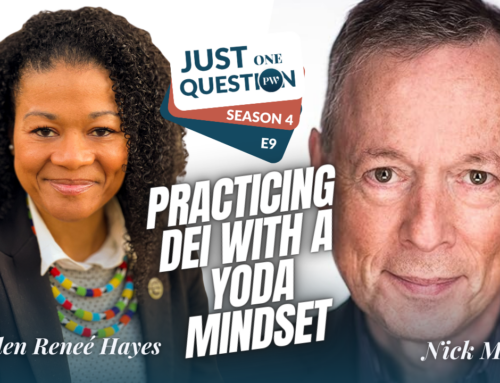The single most common mistake public speakers make in creating a speech or presentation is to think of it as an information dump, and to try to tell the audience a lot of information about something.
A speech is a very poor way to convey information. We can only remember 3 or 4 things at a time, so if you start speaking with the intent of giving us information for an hour, say, you’ll tell us many more things than that, and we’ll forget most of them.
This is a waste of everyone’s time.
There is a better way.
Instead, think of a speech as a decision-making journey you take the audience on. You want to change the audience’s mind about something, right? That’s why you’re there, in front of them, talking. So respect their decision-making process. Allow them to get your story in an order and structure that makes sense for their needs.
Audiences come into a speech asking why? — why is this important, why should I care, why should I pay attention? So your first step is to answer that question, quickly, in the first 3 minutes or so. “We’re here today to talk about how the yak butter production levels are falling – alarmingly. I’ve got an idea for how to fix the problem.”
Note that you don’t preview the entire solution at first. Why? The audience isn’t ready to hear it yet. So just answer the why question at a high level.
Then take them on the journey through the problem you’ve identified. The goal is to take them on the decision-making journey from why to how. If you answer the why question well, and then dive into an interesting problem the audience has, and then discuss your solution (this is where you get to talk about all that interesting information – the audience is now ready to hear it) and end with what you’re all going to do about it — your audience will be happy bunnies because their needs have been respected.
If you do all that with some intelligence and passion, the audience will ask “how” questions at the end – how can I get started? How can I make this work for me? What would a yak butter production system such as you’re describing cost?
That’s it – why to how. That’s your job as a speaker. Not a data dump. Enjoy.








Nick – you make a great point about the intention of the speech as a means by which to take the audience on a decision-making journey vs a data dump. Do you have any suggestions on best practices for engaging large, mixed audiences, for example in talks given at industry events/trade shows?
Nick – you make a great point about the intention of the speech as a means by which to take the audience on a decision-making journey vs a data dump. Do you have any suggestions on best practices for engaging large, mixed audiences, for example in talks given at industry events/trade shows?
Hi, Sarah —
It’s your job to understand your audience as thoroughly as you can. Find the common elements — the hopes and fears that everyone in the audience shares. If it’s truly ‘mixed’ then sometimes the best way is to acknowledge that. There are a couple of ways to handle that. You might begin by polling the audience by show of hands about their various needs or interests. Then, frankly address those differences. “For those of you who are interested in product X, I’ll be talking about that in a minute. But first, let’s talk about product Y.” Without know more about your particular case, it’s hard to be more specific.
Hi, Sarah —
It’s your job to understand your audience as thoroughly as you can. Find the common elements — the hopes and fears that everyone in the audience shares. If it’s truly ‘mixed’ then sometimes the best way is to acknowledge that. There are a couple of ways to handle that. You might begin by polling the audience by show of hands about their various needs or interests. Then, frankly address those differences. “For those of you who are interested in product X, I’ll be talking about that in a minute. But first, let’s talk about product Y.” Without know more about your particular case, it’s hard to be more specific.
Nick – I’m all for brevity and making fewer, better points. However, I don’t think you can ever say this is the formula for success, don’t deviate from it.
To me, the most important element in any presentation is not the content or the supporting imagery, but how engaging the presenter is.
How well a presentation is delivered makes the biggest difference and the biggest impression.
The other aspect of presenting one should never underestimate is the relationship between the presenter and their audience. Who you are, what you’re talking about, where you’re talking about it and who you’re talking to all impact on how you and what you’re presenting are perceived.
Having been in the live events business for 25 years, much of that time putting words in other peoples’ mouths, I know there’s much more to a successful presenter than the script they’re reading or the images supporting what they’re saying. So yes, brevity and focus are important, but they are just two of many things you need to get right.
Sticking to a formula is all well and good, but if everyone takes the same approach presentations would be very predictable. For me, every presentation needs to be approached in the same way, but executed differently. The key questions you need to ask are: What do we need to say? What’s most important? What’s the best way to get that across? And most essential, What can we leave out?
Ultimately, like most things in life, there’s more than one right way, but finding the right one is always the biggest challenge.
Nick – I’m all for brevity and making fewer, better points. However, I don’t think you can ever say this is the formula for success, don’t deviate from it.
To me, the most important element in any presentation is not the content or the supporting imagery, but how engaging the presenter is.
How well a presentation is delivered makes the biggest difference and the biggest impression.
The other aspect of presenting one should never underestimate is the relationship between the presenter and their audience. Who you are, what you’re talking about, where you’re talking about it and who you’re talking to all impact on how you and what you’re presenting are perceived.
Having been in the live events business for 25 years, much of that time putting words in other peoples’ mouths, I know there’s much more to a successful presenter than the script they’re reading or the images supporting what they’re saying. So yes, brevity and focus are important, but they are just two of many things you need to get right.
Sticking to a formula is all well and good, but if everyone takes the same approach presentations would be very predictable. For me, every presentation needs to be approached in the same way, but executed differently. The key questions you need to ask are: What do we need to say? What’s most important? What’s the best way to get that across? And most essential, What can we leave out?
Ultimately, like most things in life, there’s more than one right way, but finding the right one is always the biggest challenge.
Hi, Gary —
Thanks for the great post. As I’ve said throughout the three years I’ve been blogging and the hundreds of blogs, of course delivery is important. And of course the relationship between the presenter and the audience is important. In fact, that’s usually the first question I ask someone — who is your audience? And the second is, what do you want your audience to do differently as a result of your speech? The purpose of the current blog was not to put a “formula” forward but rather to give pointers to people based on the common mistakes I’ve seen over 30 years of coaching people, writing speeches, and designing conferences.
Hi, Gary —
Thanks for the great post. As I’ve said throughout the three years I’ve been blogging and the hundreds of blogs, of course delivery is important. And of course the relationship between the presenter and the audience is important. In fact, that’s usually the first question I ask someone — who is your audience? And the second is, what do you want your audience to do differently as a result of your speech? The purpose of the current blog was not to put a “formula” forward but rather to give pointers to people based on the common mistakes I’ve seen over 30 years of coaching people, writing speeches, and designing conferences.